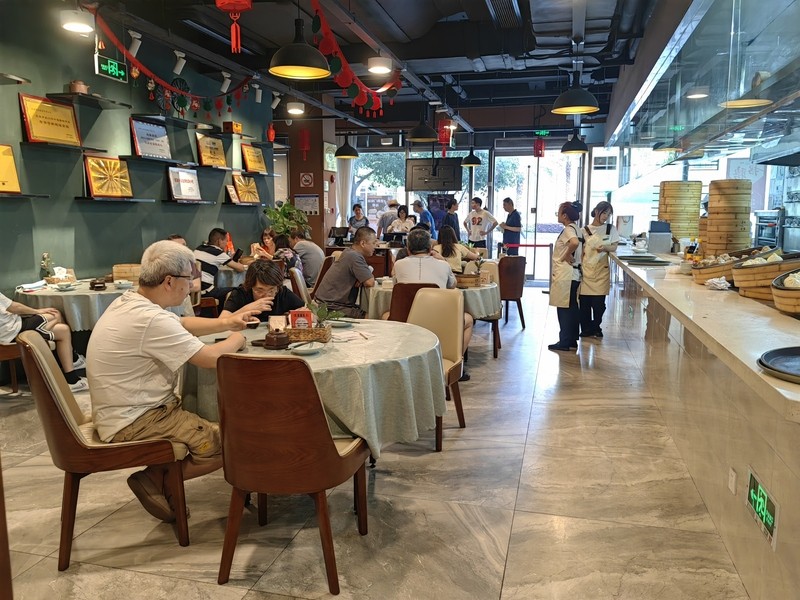I'm still running, exclusive interview with Mo Yan: Knowing Old and Forgetting Old Calligraphy | Novels | Mo Yan
Scholars have likened Mo Yan's novels to the wild grass in calligraphy.
In 2014, Mo Yan said in an interview with Jiefang Daily that he was "crazy". Over the years, he has rooted his feet in the land of China, went to various places to search for folk calligraphy, studied classical literature, and turned the bits of life into writing and ink.
Not long ago, Mo Yan came to the scene of "Zhuang Tour and Long Song-Mo Yan/Wang Zhen Two Bricks and Ink News Special Exhibition" held by Shanghai Long Art Museum. When interviewed by reporters again, his speech was as interesting as his calligraphy and poetry.
Symbiosis of writing and ink
Shangguan: Your father once said, "Words are the best clothes for men and also the best clothes for women." Is this related to your practice of calligraphy?
Mo Yan: In my father's era, there were very few people in the folk who could write or read, and the village would look up to those who could write with a good brush. Therefore, I have had the idea of writing calligraphy well since I was young. As I grew up, I saw that people who were good at writing were often respected, and I even felt that waving my hair was a fascinating state. But later on, I kept writing novels with a pen and didn't have time to practice calligraphy.
In 2005, I went abroad with a visiting delegation and wanted to bring some calligraphy works as gifts to foreign friends. A few friends encouraged me to write it myself, but the calligraphy I wrote at that time was really lacking. After returning to China, I started practicing. Although I haven't written every day for the past 18 years, I have been practicing non-stop.
In 2018, I set up a WeChat official account called "Two Bricks and Ink News" with Wang Zhen, President of Beijing Shutong Culture and Art Research Association. Afterwards, I often picked up my pen to write. At the beginning, it was copying and copying, but as I traveled more and more to "open my eyes and see the world", my calligraphy and poetry creation merged into a whole, gradually forming a creative concept: the unity of knowledge and action, the integration of writing and text, and the symbiosis of writing and ink.
What is the state of "coexistence of writing and ink"?

Mo Yan: The symbiosis of writing and ink is actually the original appearance of Chinese calligraphy art.
When Yan Zhenqing wrote "Sacrificing Nephews Manuscripts", Wang Xizhi wrote "Preface to the Orchid Pavilion Collection", and Su Dongpo wrote "Cold Food Calligraphy", they never expected that their calligraphy would be regarded as a treasure and constantly imitated by future generations. Yan Zhenqing wanted to write a eulogy, filled with grief and indignation, to mourn his nephew. Wang Xizhi recorded a recent gathering through a travelogue. When they brush their hair, the first thing that comes to mind is the article, not how to create a calligraphy work. Their brushstrokes are naturally created to record words. And the reason why their writing conforms to the aesthetic and norms of calligraphy is actually a subconscious reaction formed through long-term training, which is a highest level. They don't consciously draw a circle here and add a character there while writing, creating a manuscript like feeling artificially. It's not like some people nowadays even intentionally mark out areas that are clearly not written incorrectly, intentionally omitting words and adding another stroke.
Over the past few years, you and Wang Zhen have created many works that are intertwined with ink and culture while walking. What scenarios can easily inspire your creative inspiration?
Mo Yan: In the past four years, we have enjoyed various geographical wonders in Northeast, Northwest, Central China and other places, and have also visited many famous historical sites. When I see the ink stains of celebrities, I will draw on my own legs; When I see someone else's poetry and prose, my throat tickles and I want to create a few lines along with them. Standing on the top of a high mountain, one cannot help but sing and shout out two lines of poetry from others. Shouting too much, one's own poetry comes out, touching the scenery brings emotions, touching the scenery brings ink.
Upper view: Most of your poems are very down-to-earth. For example, a while ago in Zibo, Shandong Province, you wrote "Why is this place so beautiful, and fireworks are the most affectionate in the world" when you "realized the enlightenment of rolling cakes and talked about poetry in strip the skewers". There is a piece of artwork in this exhibition that is also very interesting: "Crickets eat the soil and spit it out, and partridges call themselves' Ge Ge Ge '.". Is this also written in my hometown of Shandong?
Mo Yan: Yes. In 2020, I returned to my hometown to live for a while. One night, it rained heavily. When I got up in the morning, I saw a small mound in the yard discharged by an earthworm. I thought it was very interesting. The first couplet came into being: "The cricket eats the soil and spits the soil.". There are three homophonic words, "eat" and "spit" are both mouth words, and "qu" and "qu" are both insect words.
Upper view: This pair is quite difficult to match.
Mo Yan: I suddenly remembered the partridges in the mountains and forests. In Tang and Song poetry, ancient people used the sound of this bird as a symbol of parting sorrow and parting hate. At that time, I happened to hear the sound of birds, and the inspiration came to me: "The partridge calls its brother to sing.".
In the eyes of some young people, calligraphy is considered lofty and has a certain distance from life. How do you view the relationship between calligraphy and current life?

Mo Yan: The reason why Chinese calligraphy has been constantly changing and developing for thousands of years is that it has always been closely related to daily life and practical applications.
In recent years, while walking around various places with Wang Zhen, in addition to searching for famous literati ink, we also visit some county-level museums to see folk calligraphy from the local history. The words left by past teachers, scholars, and even some accountants are very interesting. These folk books covered in historical smoke and dust have given us a lot of inspiration. We will also pay attention to the signs of some small shops on both sides of the road. For example, we went to Phoenix in Hunan and took many photos of the signs. Some of these signs were written by local calligraphers, while others were written by the shop owners themselves, reflecting their personalities.
"Learning from the people" is not just a slogan, nor is it just a concept that novel creators and poets should practice. Calligraphy creators should also realize the importance of "learning from the people".
I think calligraphy should not be detached from real life, especially from the daily lives of ordinary people. The process of writing calligraphy is actually paying tribute to the ancients and learning from traditional culture. When writing with a brush in hand, one will have a deeper understanding of the ancients and open up channels connecting the past and present. If calligraphy becomes purely an object of appreciation for literati and scholars hanging on walls, it will lose its strong vitality.
Mo Yan and Wang Zhen in Badaling Great Wall Pictures from "Two Bricks and Ink News"
Criticizing you is better than ignoring you
Upper view: Many of your calligraphy works are written with your left hand, why use your left hand?
Mo Yan: During the practice, I feel that the calligraphy I write with a brush is a bit like an enlarged fountain pen. After all, I have written with a pen for most of my life, and even if I write with a brush smoothly, it is still difficult to change my habit of using force and pen. Of course, these habits can be corrected to some extent through copywriting, but muscle memory is difficult to change. Once you enter a state of selflessness, the habits you have developed over the years will come to me again.
So I had a sudden idea and started writing with a brush with my left hand. At first, it was awkward, but after persisting for a period of time, it became more and more flexible, and the coordination between the heart and hands became more and more harmonious. My friend was surprised to see that the pen words I wrote with my right hand had also undergone significant changes, possibly due to a connection between the left and right hemispheres of the brain. Later on, writing with my left hand became a norm in my writing process. Sometimes when my right hand was not satisfied with my writing, I switched to my left hand and wrote for a while, and I really felt satisfied. Now I can exchange my left and right hands to write, which is also pursuing a sense of clumsiness and unfamiliarity.
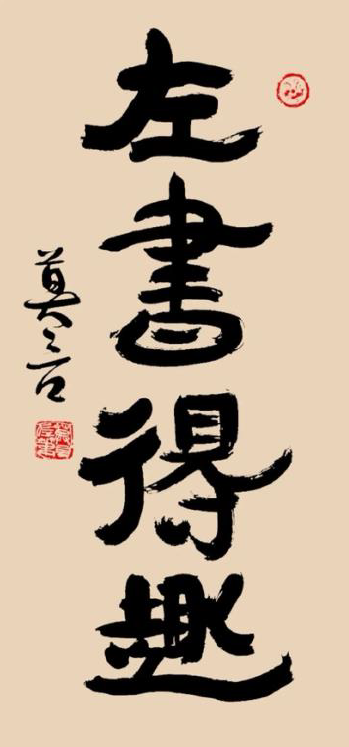
Looking up: Holding a calligraphy exhibition inevitably leads to hearing different voices. What kind of mentality would you approach it with?
Mo Yan: I have been engaged in literary creation for over 40 years, accompanied by criticism. Criticizing you is better than ignoring you, and reasonable criticism can also promote progress. Literary works are like this, as are poetry and calligraphy creations.
A few years ago, I also held an exhibition and heard some sharp criticism, especially some comments online that were not very polite. When I first started learning to write with a brush, I often gave away a piece of calligraphy as a gift. At that time, I was still proud and thought I wrote well. Years later, when the original characters were shared by netizens, I blushed and thought to myself: such ugly characters were actually given to someone else, and some were even auctioned off. This is all a lesson. Of course, without the initial practice, I would not have had the relatively mature insights in calligraphy today.
Since I came to Shanghai to hold an exhibition this time, I am prepared to be criticized. I hope that some viewers will read our calligraphy and say, "These two people don't write as well as me," and then pick up a brush to create it themselves.
If calligraphy becomes the behavior of a few people and the soil is not fertile, it will be difficult to grow strong trees. If everyone is writing, naturally there will be great calligraphers. In this sense, the two of us are trying to throw bricks and attract jade. We are not calligraphers, but enthusiasts of calligraphy and poetry creation. We hope to arouse everyone's enthusiasm for writing with brushes and learning classical poetry.
In recent years, have you also done some charity work through your calligraphy works?
Mo Yan: Starting from the Spring Festival of 2022, we have established the "Mo Yan Tongxin" public welfare project at the China Charity Federation, using my calligraphy works to raise funds and assist children with congenital heart disease in poverty-stricken areas in the west. So far, more than 280 sick children have received assistance and undergone surgery.
When we held these children's little hands and accompanied them to Tiananmen Square, we felt a huge comfort in our hearts. This kind of comfort does not match our efforts. We give very little, but we get a lot. We are not worthy of the deep bow of our children's parents, nor are we worthy of their emotionally charged cries of "grandpa" and "teacher", all of which motivate us to do more.
For a while, I was a bit pessimistic and felt like I was no longer useful. By helping these children, I realized that I still have a little use for myself and the ability to help others relieve their pain. I think charity is not just about giving, but also about gaining. It seems that we have helped these children, but in reality, they have helped me, making me lively and energetic. They have made me run on the road in my early years and have given me abundant creative passion. I want to write novels, opera, poetry, calligraphy, and even dream of crossing the Yellow River and singing in the snow.
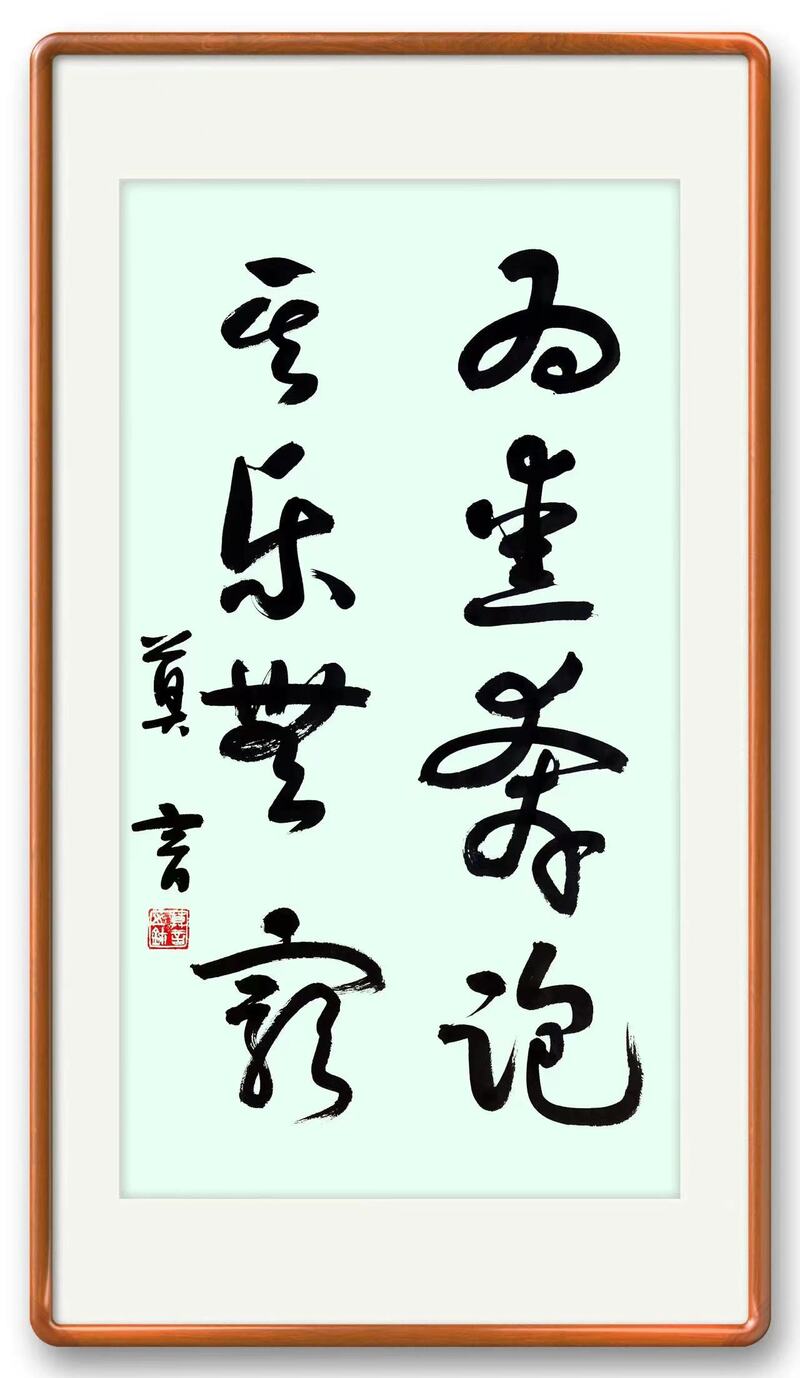
Mo Yan: It's fun to run for love. The picture comes from "Two Bricks and Ink News"
Both solemn and humorous
What is the difference between your current state of mind and when you first won the Nobel Prize in Literature more than a decade ago? How have you faced the pressure of "surpassing yourself" over the years?
Mo Yan: When I first won the award, I was a bit reserved, afraid that my words might cause trouble in one way or another, but the tree wanted to be quiet and the wind didn't stop. Since that's the case, I just let go and do my own thing.
From above: So, besides literary creation and calligraphy, do you also spend a lot of time studying classical literature?
Mo Yan: I am relatively lacking in classical literature. In fact, it is not only those of us who have not received a complete university education who lack it, but even current college students who do not study classical literature may have many gaps in this area. But like Lu Xun and his generation of cultural figures, they all have children's skills. Their learning of classical literature and traditional culture has always accompanied their growth, and now we can only make up for this lesson through diligent learning.
This is also a transformation for me. At this age, I need to make changes in my creativity and make new progress, which may be a way.
Upper view: You have just published your first poetry and calligraphy collection, "Three Songs in a Row," among which "Red Leaf Song of Whale Sea" is an ancient style long poem with over 200 lines. Why is one obsessed with writing classical poetry?
Mo Yan: Writing classical poetry is like dancing in shackles, requiring a lot of knowledge, vocabulary, and language accumulation. Only by accumulating enough can we choose words that not only conform to the tone but also express the intended meaning. Through such accumulation and learning, I feel as if I have seen light in chaos.

Nie Gannu once wrote a poem: "A long handled sickle sways on all sides, and the tall grass in front of him is draped in profusion. The wind and clouds roar in anger over the Tianshan Mountains, and the imperial edict sings wildly about the sorrow of the earth mother. The Yellow River flows all day long, and sometimes the reed pipe blows in the mouth. Mo Yan is afraid of many words being defeated, and the grass binds the mouth of the Jin people." He wrote this poem "Moyan as a Gift of Cutting Grass" with very everyday, very folk, and very "earth" elements, but of course, this "Moyan" is not me. This writing style of "old wine in old bottles" has created a rich interest, both solemn and humorous, which may be a way out for classical poetry. The ancient style poetry written by Lu Xun also has this flavor, and I think this may be a foothold and direction for contemporary people to write ancient style poetry.
Recently, the People's Literature Publishing House published Mo Yan's first poetry and calligraphy collection, "Three Songs in a Row"
Looking up: Which is more difficult to write poetry or calligraphy?
Mo Yan: It's all very difficult. I can write 10 poems a day, but I may never be able to write such beautiful lines as "The mountains and rivers are heavy, and there is no way out. The willows and flowers are dark, and another village is bright." "The boundless falling trees are rustling, and the endless Yangtze River is rolling." These beautiful lines are rare and hard to come by.
The same goes for calligraphy. Aspiring to write a good calligraphy work is actually impossible. Sometimes my friends ask me to write the title or study number of a book, and I take it very seriously and write one after another. The next day, when I look at it, the first one is still the best. Many people have asked me what my next goals or dreams are in life. Actually, becoming a calligrapher is not my dream.
Looking up: So what is your dream?
Mo Yan: Be a playwright. In 2019, several teachers from the Writing Center of Beijing Normal University, including Yu Hua, Su Tong, and others, went to Shakespeare's old residence together. Before the statue of Shakespeare, I swore to complete a transition from novelist to playwright in the latter half of my life. They were both laughing at the time. I hope one day when the three of us stand together and someone introduces us, they will say: Mo Yan, playwright; Yu Hua and Su Tong are novelists.
My play script "Crocodile" is about to be published, telling the story of corrupt officials who have fled abroad. I have worked at the Procuratorial Daily affiliated with the Supreme People's Procuratorate for 10 years, interviewing some prosecutors and corrupt elements, and accumulating materials on corrupt officials who have fled overseas.
Upper view: You once said that every work of yours will have its own shadow. Is there you in "Crocodile"? It is said that the creation of this work lasted from 2009 to 2022, why is it so long?
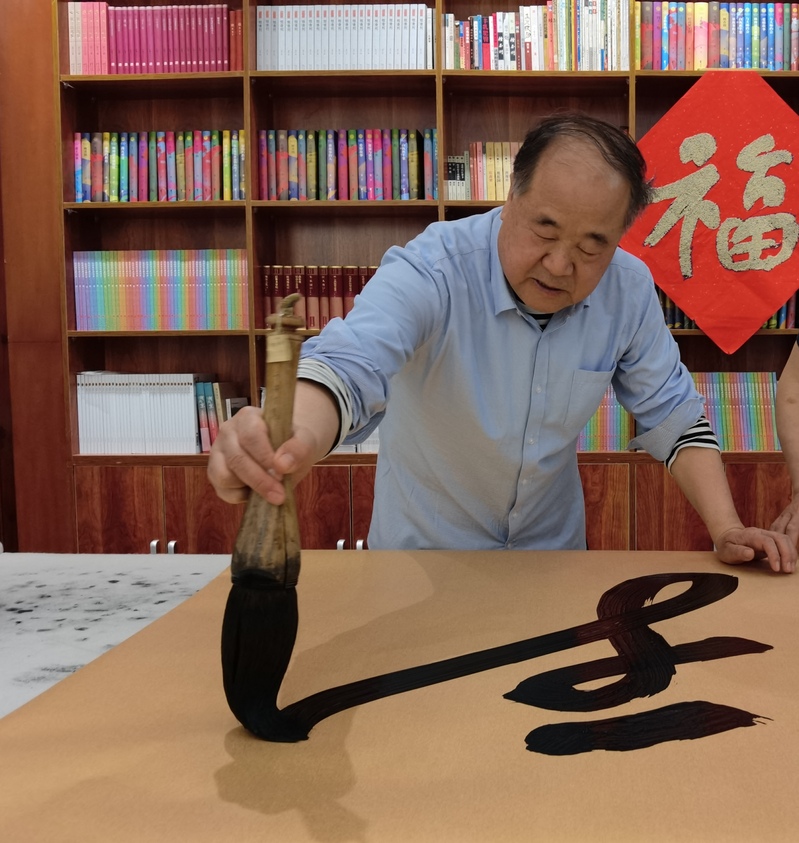
Mo Yan: Writers should have the ability to assimilate the lives of others into their own, which means they should be empathetic. When writing about corrupt officials, one should assimilate oneself into corrupt officials; When writing heroes, of course, one must also assimilate oneself into a hero. The reason why "Crocodile" took so many years to complete is mainly because I have participated in many social activities in recent years, and at the same time, I have put a lot of energy into walking the mountains, rivers, and land, accumulating life experience and writing materials.
What is the biggest attraction of writing a script to you compared to novels?
Mo Yan: Drama is the art of language, the art of dialogue, and the art of shaping characters. The greatest charm of a play lies in its lines. The elasticity of language itself, the hints, metaphors, humor, and subtext behind language are all full of charm. Half of the words in a truly excellent play are added by the audience themselves, and there are many unspoken lines from the actors on stage.
Shangguan: What kind of dramas do you usually like to watch?
Mo Yan: I am willing to watch any drama, but my favorite is still drama. I prefer to watch more traditional and typical character portrayals in plays.
My interest in traditional Chinese opera has been maintained since childhood until now. My first work after winning the Nobel Prize was "Jin Yi", which was published in People's Literature in 2017. It is a traditional Chinese opera text, and I have always hoped to turn it into a Peking Opera. Mr. Shang Changrong, a renowned Peking Opera master in Shanghai, has read this script and said it is very good. I feel like I have obtained a graduation certificate to receive recognition from someone as prestigious as Mr. Shang.
"Folk" is a lively element like mercury
Upper view: In your poetry, calligraphy, and photography works, there is a kind of "inexplicable" interest, which contains your outlook on life?
Mo Yan: Fun, in a sense, is a manifestation of childlike innocence. If an artist lacks childlike innocence and playfulness, their creations will lose vitality. If there were no vivid and interesting insects and shrimp in Qi Baishi's paintings, his paintings would be greatly reduced in color. If there were no innocent and lively young boys and girls in "Dream of the Red Chamber", "Dream of the Red Chamber" would not have been established.
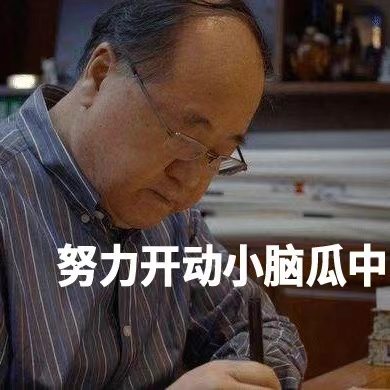
I am in my early years and know that I am old, but I do not consider it a burden, let alone a capital. Instead, I hope to inject vitality into my life through creation. This is called "knowing old and forgetting old".
Shangguan: In addition to the "Two Bricks and Ink News", you also have a WeChat official account named after yourself. The articles in the account are very grounded, and you also have your own expression pack. Why do you communicate with young people in this way?
Mo Yan: The purpose of opening "Mo Yan" official account is actually to chat with young people. I think many young people don't know me very well and have a vague impression of me. This official account gives us a chance to communicate, so that I won't be eliminated prematurely by this era, and my literary creation can be full of fresh flavor of the times. Not afraid of change, keeping up with the times, learning new things, accepting new ideas, and changing old concepts. I believe this is not only a person, but also the most fundamental reason for a society to maintain vitality and progress.
Seeing many people leave messages calling me "grandpa", I feel very warm and happy, and at the same time, I feel really old. I am also trying to create more opportunities for direct communication with young people.
Last year, after the completion of the East Hall of the Shanghai Library, a small exhibition was held to celebrate my 10th anniversary of winning the Nobel Prize. Many viewers wrote letters to me, and I read them all one by one. I tried my best to return them if possible. I think communication between people is particularly important, and communication between the older and younger generations is even more important. I never think there is a generation gap when communicating with young people. Even if there is a generation gap, it can be filled through sincere understanding and communication, at least it can be narrowed. Young people try to understand the elderly, and the elderly also try their best to understand young people.
Interesting expression packs often appear on "Mo Yan" WeChat official account
Upper view: You just talked about liking to go to different places to see folk calligraphy. Does folk wisdom also bring you different inspirations and fun?
Mo Yan: Yes. As a literary creator, one must pay attention to social life and people, so one must keep their eyes down because all great literary creations originate from the folk.
In fact, "folk" is also a concept that is constantly enriching and developing. In the past, when we talked about the people, we mainly referred to the cultural forms that exist in the lives of grassroots people, farmers, workers, and citizens. Now, with the rapid development of society, various new technologies are rapidly changing our living conditions. "Folk" is a lively element like mercury. The things you focused on yesterday may have changed today, so we need to keep up with the times, strive to stand at the forefront of life, and be the trendsetters in life.
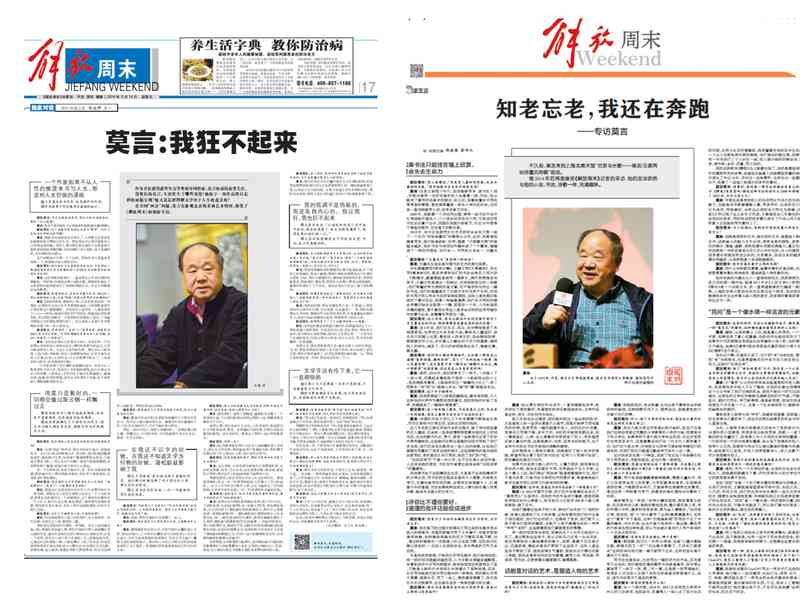
Looking up: In the "folk" world, besides your works, there are also your life mottos that are most widely circulated, such as "Mo Yan: the wisest way for adults to socialize, not to argue, not to be true!" and so on. Is that what you said? What do you think of these "soul chicken soup"?
Mo Yan: Many proverbs and aphorisms posted in my name online are beyond my ability to write, and I dare not take advantage of them. There are also some that do not align with my beliefs, and I have no time to point them out one by one. I believe in the reader's judgment and understand the struggles of these fake publishers.
Looking up: A while ago, you participated in an award ceremony for Harvest magazine in Shanghai and mentioned that you used the popular ChatGPT to prepare your award speech for Yu Hua. How do you view artificial intelligence? Do writers need to feel a sense of crisis being replaced by artificial intelligence?
Mo Yan: I once tried to write a seven character regulated poem about bidding farewell by the riverbank using ChatGPT. I entered some keywords into it, such as riverbank, late autumn, red leaves, big river, and sailboat, and instantly generated a regulated poem that completely met the technical requirements, but it was all clich é s and seemed to be something I had known before. However, it is not yet clear whether artificial intelligence can write good sentences like "Peach Blossom Pond water is a thousand feet deep, not as deep as Wang Lun's love for me" in the future.
Mo Yan was interviewed twice by Liberation Daily in March 2014 and June 2023.


